 |
 |
 |
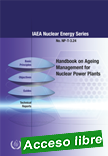 |
Handbook on Ageing Management for Nuclear Power Plants
IAEA Nuclear Energy Series, 2017, 152 p.
This handbook on ageing management for nuclear power plants (NPPs) has been developed in compliance with relevant IAEA safety standards and draws on lessons learned from ageing management practices worldwide. It provides an overview of the topic and guidance on proactive ageing management within NPPs. The publication also collates information on ageing mechanisms, effects on structures, |
systems and components, the regulatory framework as well as some details on innovative techniques and research and development in the area. The information is presented concisely with clear flow charts and with structured reference to the underlying principles. The handbook will support NPP staff, maintenance managers, vendors, personnel at research organizations and regulators in their work related to the ageing of structures, systems and components.
Extraído de: http://www-pub.iaea.org/books/IAEABooks/10956/Handbook-on-Ageing-Management-for-Nuclear-Power-Plants |
 |
 |
Investigations of Materials under High Repetition and Intense Fusion Pulses - Report of a Coordinated Research Project 2011–2016
IAEA TECDOC, 2017, 300 p.
This publication presents experimental simulations of plasma-surface interaction phenomena at extreme conditions as expected in a fusion reactor, using dedicated test bed devices such as dense plasma focus, particle accelerators, plasma accelerators and plasma guns. It includes the investigation |
of the mechanism of material damage during transient heat loads on materials and addresses, in particular, the performance and adequacy of tungsten as plasma facing material for the next step fusion devices, such as ITER and fusion demonstration power plants. The publication is a compilation of the main results and findings of an IAEA coordinated research project on investigations on materials under high repetition and intense fusion pulses, conducted in the period 2011–2016 and provides a practical knowledge base for scientists and engineers carrying out activities in the plasma-material surface interaction area.
Extraído de: http://www-pub.iaea.org/books/IAEABooks/11094/Investigations-of-Materials-under-High-Repetition-and-Intense-Fusion-Pulses |
 |
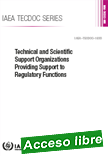 |
Technical and Scientific Support Organizations Providing Support to Regulatory Functions
IAEA TECDOC, 2018, 64 p.
This publication introduces the general principles underlying the provision of technical and scientific support to a regulatory body and the characteristics of organizations providing such support. It describes the services provided to support regulatory functions as well as the associated activities and processes to maintain the needed level of expertise, state of the art tools and equipment. It is the first IAEA publication dedicated to the specific practices and challenges to be met by the technical and scientific support organizations.
|
Extraído de: https://www-pub.iaea.org/books/IAEABooks/12267/Technical-and-Scientific-Support-Organizations-Providing-Support-to-Regulatory-Functions |
 |
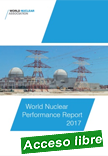 |
More than 9 GWe of new nuclear capacity came online in 2016, the largest annual increase for over 25 years. By the end of 2016 there were 448 reactors around the world, up from 441 at the start of the year. Ten reactors started to supply electricity and three were closed down, resulting in a net increase in nuclear capacity of just over 8 GWe. The amount of electricity supplied by nuclear globally increased by 35 TWh to 2476 TWh.
|
This increased generation is the result of both additional generation from new reactors coming online and continued performance improvements from the existing fleet.
construction has fallen from 68 at the start of 2016. There has been a pause in new reactor construction starts in China; however, the pouring of first concrete for Tianwan 6 in September marked the resumption of reactor construction.The first Korean-designed APR-1400, unit 3 at the Shin Kori nuclear power plant, was connected to the grid by Korea Hydro and Nuclear Power in January. Construction of four APR-1400 reactors at Barakah in the United Arab Emirates continued to make good progress and the first reactor is due to startup next year. In Russia the first VVER-1200 at Novovoronezh II, was connected to the grid in August.2016 saw the start-up of Watts Bar 2, the first reactor connected to the grid in the United States in 20 years. But it also saw continuing challenges to the operation of some reactors in deregulated markets and the ongoing construction of four reactors at VC Summer and Vogtle. More must be done to ensure nuclear plants can compete in a fair electricity market.The process of gaining regulatory approval for the restart of reactors in Japan is proving to be protracted and extensive and some restarts have been delayed by legal challenges. However, five reactors have now restarted and a further 19 have applied to do so.In the UK in 2016, the go-ahead was given for Hinkley Point C, the first of a planned new generation of nuclear power plants in that country. Nuclear remains the largest single source of low carbon generation in Europe, but political pressure in some countries is threatening this.The world’s nuclear power plants have performed well this year, making a significant contribution to meeting the need for clean, reliable and affordable electricity. But more will need to be done to ensure this contribution grows as it will need to over the coming decades in order to meet the Harmony goal of supplying 25% of the world’s electricity by 2050.
Extraído de: http://www.world-nuclear.org/our-association/publications/online-reports/world-nuclear-performance-report.aspx
|
 |
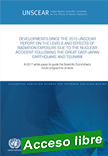 |
Developments since the 2013 UNSCEAR Report on the levels and effects of radiation exposure due to the nuclear accident following the great east-Japan earthquake and tsunami - A 2017 White Paper to guide the Scientific Committee's future programme of work
United Nations Scientific Committee on the Effects of Atomic Radiation (UNSCEAR), 2017, 58 p.
The third UNSCEAR White Paper on this subject continues the ongoing effort to systematically monitor and evaluate relevant, new scientific information that has emerged since the launch of |
the Committee's 2013 Report on the Fukushima Daiichi accident. Including the 2015 White Paper and the 2016 White Paper, more than 300 publications have been reviewed, from October 2012 onwards. The 2017 White Paper presents a sound analysis of the recent information, to identify whether it materially affected conclusions of the 2013 Report or if it addressed research needs that had been identified. The thematic areas covered: releases and dispersion for the atmosphere and marine environment; transfer of radionuclides in terrestrial and freshwater environments; evaluations of doses for the public and workers; health implications for the workers and the public; and doses and effects for non-human biota. The 2017 White Paper also summarizes major research projects/programmes which are currently ongoing in the Japanese research community. This is also elaborated in the electronic attachment.
Extraído de: http://www.unscear.org/unscear/en/publications/Fukushima_WP2017.html
|
 |
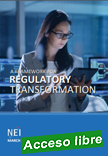
|
A Framework for Regulatory Transformation
Nuclear Energy Institute (NEI - US), March 2018, 19 p.
The U.S. nuclear industry’s safety record is exemplary and a model for the nuclear industry worldwide. For years, NRC regulation had served to support this global leadership. However, recent changes in technology, understanding of risks and margins, and improvements in licensee performance have created a landscape where new regulatory approaches are needed to maintain NRC effectiveness. These new approaches must achieve change beyond an incremental evolution to enable |
the modernization of the U.S. nuclear industry.
This report provides recommendations for key elements of the vision for a transformed NRC, along with an initial set of actions to achieve the needed change in a timely, effective and sustained manner. These recommendations build on the NRC’s Principles of Good Regulation – independence, openness, efficiency, clarity, and reliability – complementing them with additional attributes to position the NRC to be effective when facing current and future changing needs and priorities.
Extraído de: https://www.nei.org/resources/reports-briefs/framework-for-regulatory-transformation
|
 |
 |
Country Nuclear Power Profiles - 2017 Edition
IAEA Non-serial Publications , 2018, s. p.
The Country Nuclear Power Profiles compile background information on the status and development of nuclear power programmes in Member States. The publication summarizes organizational and industrial aspects of nuclear power programmes and provides information about the relevant legislative, regulatory and international framework in each State. Its descriptive and statistical overview of the overall economic, energy and electricity situation in each State and its nuclear
|
power framework is intended to serve as an integrated source of key background information about nuclear power programmes throughout the world. This 2017 edition, issued on CD-ROM, contains updated country information for 50 States.
Extraído de: https://www-pub.iaea.org/books/IAEABooks/12350/Country-Nuclear-Power-Profiles |
 |
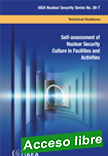 |
Self-assessment of Nuclear Security Culture in Facilities and Activities -
Technical Guidance
IAEA Nuclear Security Series, 2017, 107 p.
The IAEA has developed a comprehensive methodology for evaluating nuclear security culture. When implemented by a State, this methodology will help to make nuclear security culture sustainable. It will also promote cooperation and the sharing of good practices related to nuclear security culture. This publication is the first guidance for assessing nuclear
|
security culture and analysing its strengths and weaknesses within a facility or activity, or an organization. It reflects, within the context of assessment, the nuclear security culture model, principles and criteria set out in the Implementing Guide, IAEA Nuclear Security Series No. 7. This guidance will be useful for organizations and operating facilities in conducting the self-assessment of nuclear security culture by providing practical methods and tools. It will also help regulatory bodies and other competent authorities to understand the self-assessment methodology used by operators, encourage operators to start the self-assessment process or, if appropriate, conduct independent assessments of nuclear security culture.
Extraído de: http://www-pub.iaea.org/books/IAEABooks/10983/Self-assessment-of-Nuclear-Security-Culture-in-Facilities-and-Activities |
 |
|
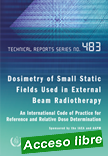
|
Dosimetry of Small Static Fields Used in External Beam Radiotherapy - An International Code of Practice for Reference and Relative Dose Determination Sponsored by the IAEA and AAPM
IAEA Technical Reports Series, 2017, 211 p.
This is the first international code of practice dedicated to the dosimetry of small static fields used in radiotherapy. It provides consistent reference dosimetry, traceable to metrological primary standards, and enables common procedures within a country to be followed. The publication presents an overview
|
of the physics, followed by a general formalism for reference dosimetry in small fields. Guidelines for its practical implementation using suitable detectors and methods for the determination of field output factors are given for specific clinical machines that use small static fields. The development of this code of practice has been done through an international working group, established jointly with the American Association of Physicists in Medicine. Internationally harmonized guidelines in this field will ensure worldwide consistency in dose delivery to radiotherapy patients and will contribute to dose standardization in international clinical trial studies, comparing outcomes of various radiotherapy treatment modalities using small fields.
Extrído de: http://www-pub.iaea.org/books/IAEABooks/11075/Dosimetry-of-Small-Static-Fields-Used-in-External-Beam-Radiotherapy
|
 |
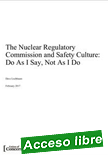 |
The Nuclear Regulatory Commission and Safety Culture (2017)
Union of Concerned Scientists, February 2017, 11 p.
Part of the job of the Nuclear Regulatory Commission—the US agency charged with reactor safety—is to ensure that workers at US nuclear power plants feel free to raise safety issues, and that management responds proactively and without rebuke. For decades, the NRC has performed this function admirably. Investigations into safety incidents regularly assess the
|
cultures that allowed the issues to arise, and the agency has repeatedly intervened to restore a positive safety culture.
And yet, despite their regulatory actions, the NRC has failed to foster a positive safety culture within the agency itself. Numerous surveys of NRC employees reveal an unacceptably high percentage of staff that’s afraid of reprisal and unwilling to contradict the agency’s official conclusions.
The percentage of NRC workers who stated they could not disclose a suspected violation of law for fear of reprisal increased every year from 2010 to 2015, with 13 percent of workers falling into this category in 2015; Surveys have shown that only 15 percent of the NRC workforce would be willing to raise a safety concern via the “Differing Professional Opinion Program”
53 percent of the NRC workforce stated their co-workers would not use an official non-concurrence process to raise a safety concern; The NRC has intervened at nuclear power plants when lower percentages of workers report fears of retaliation. Congress should compel the NRC to follow its own standard.
Extraído de: https://www.ucsusa.org/nuclear-power/whos-responsible-nuclear-power-safety/nrc-safety-culture#.WrEGXR3wa70
|
 |
 |
Second License Renewal Road Map
Nuclear Energy Institute (NEI - US), May 2017, 23 p.
By 2030, the United States could experience electricity shortages if a significant number of nuclear power plants are retired in a short period. Replacing the nearly 100 gigawatts of electrical generating capacity would cost hundreds of billions of dollars and lead to significant increases in greenhouse gas emissions if fossil fuel plants replace nuclear plants. One way to avoid this outcome is renewing the operating licenses of nuclear power plants
a second time for up to an additional 20 years.
|
|

|
|
|
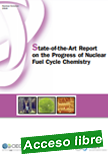 |
State-of-the-art Report on the Progress on Nuclear Fuel Cycle Chemistry
Nuclear Energy Agency (NEA), 19/03/18, 291 p.
The implementation of advanced nuclear systems requires that new technologies associated with the back end of the fuel cycle are developed. The separation of minor actinides from other fuel components is one of the advanced concepts being studied to help close the nuclear fuel cycle and to improve the long term effects on the performance of geological repositories.
|
Separating spent fuel elements and subsequently converting them through transmutation into short lived nuclides should considerably reduce the long-term risks associated with nuclear power generation.
R&D programmes worldwide are attempting to address such challenges, and many processes for advanced reprocessing and partitioning minor actinides are being developed. This report provides a comprehensive overview of progress on separation chemistry processes, and in particular on the technologies associated with the separation and recovery of minor actinides for recycling so as to help move towards the implementation of advanced fuel cycles. The report examines both aqueous and pyro processes, as well as the status of current and proposed technologies described according to the hierarchy of separations targeting different fuel components. The process criteria that will affect technology down selection are also reviewed, as are non proliferation requirements. The maturity of different reprocessing techniques are assessed using a scale based on the technology readiness level, and perspectives for future R&D are reviewed.
Extraído de:http://www.oecd-nea.org/tools/publication?query=&div=&lang=&period=6m&sort=title&filter=1#p7267
|
| |
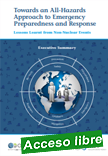 |
Executive Summary of Towards an All-Hazards Approach to Emergency Preparedness and Response
Nuclear Energy Agency (NEA), 26/02/18, 11 p.
Over the years, member countries from the OECD Nuclear Energy Agency (NEA) have developed effective emergency preparedness and response (EPR) arrangements for nuclear facilities and off-site response organisations. These arrangements have usually been tested through exercises involving the facility and off-site response organisations.
|
EPR arrangements have thus been enhanced as necessary to include lessons learnt from nuclear emergency exercises, nuclear power plant accidents such as the accident at Fukushima Daiichi and changes to international guidance. While nuclear power plant accidents are very rare, industrial non-nuclear events and natural disasters occur more frequently and can have a potentially large impact on populations and on widespread geographical areas. As a result of these events, populations may be required to take part in protective actions such as sheltering, evacuation and the restriction of food supplies. Research on these types of non-nuclear events and natural disasters has been extensive and has led to an understanding of factors that have supported the effectiveness of response activities, as well as those factors that may have degraded the response. This type of information can be used to enhance existing preparedness efforts for nuclear power plants, for other industrial facilities and for natural disasters in an “all-hazards” framework.
In recognition of the importance of an all-hazards approach to preparedness and
response, the International Atomic Energy Agency (IAEA) General Safety Requirements (GSR No. 7), Preparedness and Response for a Nuclear or Radiological Emergency (IAEA, 2015), encourage, to the extent practicable, the inclusion of the emergency management system in an all-hazards framework. The OECD Council similarly supports the integration of a nuclear emergency management system into a comprehensive, all-hazards and transboundary approach to country risk governance as a foundation for enhancing national
resilience and responsiveness. Contributions to this report support the value of such an all hazards approach to EPR.
Extraído de:http://www.oecd-nea.org/rp/pubs/2018/7436-all-hazards-epr-es.pdf
|
| |
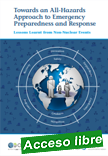 |
Towards an All-Hazards Approach to Emergency Preparedness and Response - Lessons Learnt from Non-Nuclear Events
Nuclear Energy Agency (NEA), 12/01/18, 104 p.
The field of emergency management is broad, complex and dynamic. In the post-Fukushima context, emergency preparedness and response (EPR) in the nuclear sector is more than ever being seen as part of a broader framework. The OECD has recommended that its members "establish and promote a comprehensive, all-hazards and transboundary
|
approach to country risk governance to serve as the foundation for enhancing national resilience and responsiveness". In order to achieve such an all-hazards approach to emergency
management, a major step in the process will be to consider experiences from the emergency management of hazards emanating from a variety of sectors.
The NEA Working Party on Nuclear Emergency Matters (WPNEM) joined forces with the OECD Working Group on Chemical Accidents (WGCA), the OECD Public Governance and Territorial Development Directorate?s High-Level Risk Forum (HLRF) and the European Commission?s Joint Research Centre (JRC) to collaborate on this report, which demonstrates similarities between emergency planning and preparedness across sectors, and identifies lessons learnt and good practices in diverse areas for the benefit of the international community.
A set of expert contributions, enriched with a broad range of national experiences, are presented in the report to take into account expertise gathered from the emergency management of hazards other than those emanating from the nuclear sector in an effort to support and foster an all-hazards approach to EPR.
Extraído de:http://www.oecd-nea.org/tools/publication?query=&div=&lang=&period=6m&sort=title&filter=1#p7308
|
| |
| |
|
|
|
